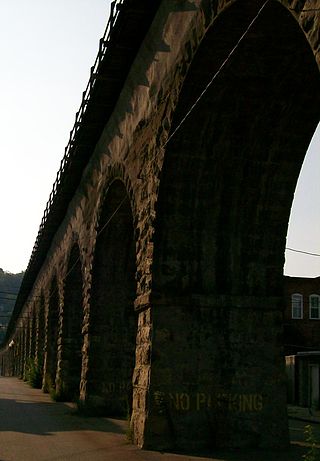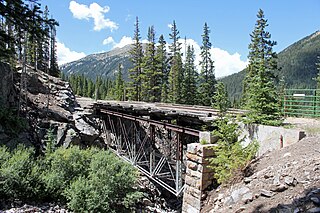
The Bollman Truss Railroad Bridge across the Little Patuxent River at Savage, Maryland, is one of the oldest standing iron railroad bridges in the United States and the sole surviving example of a revolutionary design in the history of American bridge engineering. The 160-foot (48.8 m) double-span was built in 1852 at an unknown location on the main line of the Baltimore and Ohio Railroad. It was moved 35 years later to its present location, where it replaced the very first Bollman bridge. Today, it carries the Savage Mill Trail.

B & O Railroad Viaduct is a historic structure in Bellaire, Ohio, listed in the National Register of Historic Places on June 22, 1976.

Shaw Bridge, also known as Double-Span Whipple Bowstring Truss Bridge, is a historic bridge in Claverack, New York, United States. It carried Van Wyck Lane over Claverack Creek, but is now closed to all traffic, even pedestrians. It is "a structure of outstanding importance to the history of American engineering and transportation technology." Specifically designed by John D. Hutchinson, the bridge employs the basic design of Squire Whipple. It is the only extant "double" Whipple bowstring truss bridge in the U.S., having two identical spans placed in series over a common pier.

The Hadley Parabolic Bridge, often referred to locally as the Hadley Bow Bridge, carries Corinth Road across the Sacandaga River in Hadley, New York, United States. It is an iron bridge dating from the late 19th century.

The Main Street Bridge formerly carried Main Street over the Rippowam River just outside downtown Stamford, Connecticut. It was designed and manufactured by the Berlin Iron Bridge Company in 1888. It is a two-span wrought iron lenticular truss bridge, each span 60 feet (18 m) long, although there are supporting piers every 12 feet (3.7 m) feet. The abutments and central pier are cut granite and other stone, faced in concrete.

The Whipple Cast and Wrought Iron Bowstring Truss Bridge, is located near the entrance to Stevens Farm in southwestern Albany, New York, United States. It was built in 1867, but not moved to its present location until 1899. It is one of the oldest surviving iron bridges in the county, one of the few that use both cast and wrought iron and one of only two surviving examples of the Whipple bowstring truss type. In 1971 it was listed on the National Register of Historic Places, the only bridge in the city of Albany so far to be listed individually.

The Clinton Falls Bridge, also known as the Old Mill Bridge and formally as Bridge L-5573, is a historic steel Pratt through truss bridge that spans the Straight River in Clinton Falls Township, Minnesota. It was listed on the National Register of Historic Places in 1997 as Bridge No. L-5573 for having local significance in the theme of engineering. It was nominated for being an example of early steel truss bridge design in Minnesota.

The Stony Creek Bridge is a bridge located on a private road over Stony Creek in Olive Township, Clinton County, Michigan. It was listed on the National Register of Historic Places in 1999. It is the last example of a queen post truss bridge extant in Michigan.

The Tilton Island Park Bridge is a foot bridge in Tilton, New Hampshire. It spans a portion of the Winnipesaukee River just east of downtown Tilton, providing access to Tilton Island Park, located on an island in the river. Built in 1881, it is a rare surviving example of a bridge with cast iron components, designed by a distinctive patent issued in 1858 to Lucius Truesdell. The bridge was listed on the National Register of Historic Places in 1980.
McMillans Bridge, is a riveted wrought iron open web truss bridge, located over the Woady Yaloak River on the Rokewood-Skipton Road between Rokewood and Werneth on a historical route between Geelong and the 1850s goldfields at Ararat and Streatham.

Mill Creek Bridge is a historic structure located in a rural area north of Clarence, Iowa, United States.The Cedar Bluff Bridge over the Cedar River was the first all-iron span built in Cedar County in 1877. Four more iron spans were built later that year, as were several others over the years before this bridge was completed in 1889. It is the only one of those bridges left, and one of the oldest pony truss bridges in the state of Iowa. Citizens in Dayton Township petitioned the Cedar County Board of Supervisors in June 1888 for the bridge over Mill Creek. The supervisors contracted with Ward and Keepers of Clinton, Iowa to design and build the bridge. The 58-foot (1,800 cm) span was built on concrete-filled iron cylinder piers, with timber stringer approach spans. Over the years sub-structural alterations have been made to the bridge. It has subsequently been abandoned and its deck is in a deteriorating condition. The bridge was listed on the National Register of Historic Places in 1998. It was relocated to Whitetails Saloon in 2020

The Cooley Covered Bridge is a covered bridge that carries Elm Street across Furnace Brook in Pittsford, Vermont. Built in 1849, it is one of a small number of bridges in the state that has a well-documented association with the 19th-century master bridgewright Nicholas M. Powers, who grew up nearby. It is one of four surviving 19th-century covered bridges in the town, and was listed on the National Register of Historic Places in 1974.
The Gilliece Bridge was a historic structure located west of Bluffton, Iowa, United States. It spanned the Upper Iowa River for 151 feet (46 m). In 1872 Winneshiek County started to replace its older short span timber and stone bridges. This Bowstring through arch-truss bridge was designed, fabricated, and built by the Wrought Iron Bridge Company of Canton, Ohio in 1874 for $6,969.47. Thomas Dwyer, a local stonemason, built the masonry abutments. The bridge was listed on the National Register of Historic Places in 1998. The bridge was destroyed in May 2017 by an overweight truck which was driven onto it despite the posted weight limit of three tons.

The Foundry Bridge is a historic Warren pony truss bridge, carrying Foundry Road across the First Branch White River in Tunbridge, Vermont. Built in 1889, it is one of the state's oldest wrought iron bridges, and the only surviving example in the state of work by the Vermont Construction Company, its only local manufacturer of such bridges. It was listed on the National Register of Historic Places in 2007.

Morpeth Bridge is a heritage-listed road bridge over the Hunter River at Morpeth, New South Wales, Australia. It was designed by Percy Allan and built from 1896 to 1898 by Samuel McGill. It is also known as Morpeth Bridge over the Hunter River. The property is owned by Transport for NSW.

The Old Boardman Bridge, formerly Boardman Bridge, is a historic lenticular truss bridge, which used to carry Boardman Road across the Housatonic River in New Milford, Connecticut. Built from 1887 to 1888 out of wrought iron, it is one of the state's three surviving examples of this bridge type, and along with Lover's Leap Bridge, one of two in New Milford. It was listed on the National Register of Historic Places in 1976. The bridge was closed to vehicles in 1984 and to pedestrians in 1985; however, the Town of New Milford is seeking to restore it and reopen it to pedestrian traffic.

The Parshallburg Bridge, also known as the Ditch Road Bridge, was a bridge that originally carried Ditch Road over the Shiawassee River near Oakley, Michigan. It was listed on the National Register of Historic Places in 1994. It was the only known Thacher through truss bridge in Michigan, and one of only a few remaining in the nation. In 1999, the bridge was moved to a new location, and in 2008 was washed off its piers and destroyed.

The Joliet Bridge, in Carbon County, Montana, near Joliet, is a Pratt through truss bridge built in 1901. It was listed on the National Register of Historic Places in 1986.

The Morley Bridge, also known as the Romley Bridge, located near Romlee in Chaffee County, Colorado, is a wrought-iron pin-connected Pratt truss bridge that was built in 1881. It was listed on the National Register of Historic Places in 2003.
The Black River Bridge near Carrizo, Arizona was funded in 1911 and built in 1912. It was listed on the National Register of Historic Places in 1988. It spans the Black River, bringing an army road, now Indian Route 9, over the river from Fort Apache to the railroad at the former town of Rice, Arizona.




















